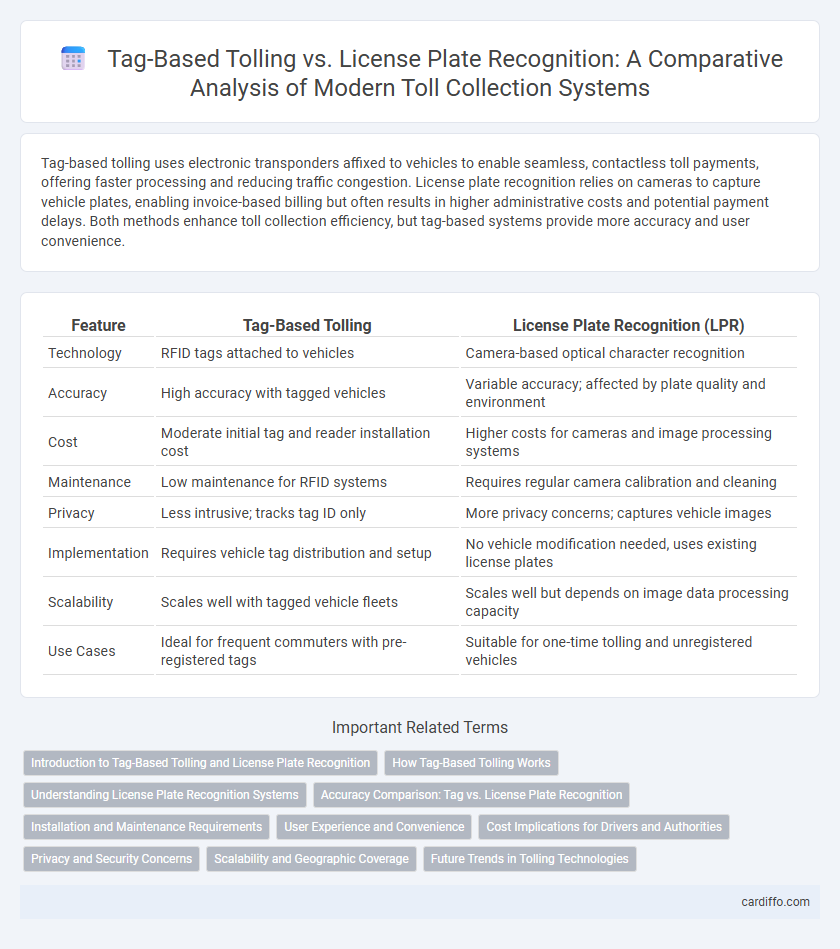Tag-based tolling uses electronic transponders affixed to vehicles to enable seamless, contactless toll payments, offering faster processing and reducing traffic congestion. License plate recognition relies on cameras to capture vehicle plates, enabling invoice-based billing but often results in higher administrative costs and potential payment delays. Both methods enhance toll collection efficiency, but tag-based systems provide more accuracy and user convenience.
Table of Comparison
| Feature | Tag-Based Tolling | License Plate Recognition (LPR) |
|---|---|---|
| Technology | RFID tags attached to vehicles | Camera-based optical character recognition |
| Accuracy | High accuracy with tagged vehicles | Variable accuracy; affected by plate quality and environment |
| Cost | Moderate initial tag and reader installation cost | Higher costs for cameras and image processing systems |
| Maintenance | Low maintenance for RFID systems | Requires regular camera calibration and cleaning |
| Privacy | Less intrusive; tracks tag ID only | More privacy concerns; captures vehicle images |
| Implementation | Requires vehicle tag distribution and setup | No vehicle modification needed, uses existing license plates |
| Scalability | Scales well with tagged vehicle fleets | Scales well but depends on image data processing capacity |
| Use Cases | Ideal for frequent commuters with pre-registered tags | Suitable for one-time tolling and unregistered vehicles |
Introduction to Tag-Based Tolling and License Plate Recognition
Tag-based tolling utilizes RFID transponders installed on vehicles to enable automatic identification and seamless toll payment, reducing congestion and enhancing traffic flow. License plate recognition (LPR) systems employ high-resolution cameras combined with optical character recognition (OCR) technology to capture vehicle license plates for toll billing without requiring physical tags. Both methods aim to improve toll collection efficiency, with tag-based systems providing quicker transactions and LPR offering flexibility for vehicles without prepaid accounts.
How Tag-Based Tolling Works
Tag-based tolling operates by using RFID technology embedded in a small electronic device affixed to a vehicle's windshield or license plate, which communicates with roadside readers at toll plazas. When a vehicle passes through a toll point, the reader scans the tag to automatically deduct the toll amount from the driver's prepaid account, enabling seamless, cashless travel. This system reduces congestion and enhances efficiency by eliminating the need for physical toll booths and manual payment.
Understanding License Plate Recognition Systems
License Plate Recognition (LPR) systems utilize advanced camera technology and optical character recognition software to automatically capture and identify vehicle license plates for toll collection. These systems enhance toll accuracy by linking registered license plates to billing accounts without requiring physical tags or transponders. By integrating real-time image analysis and database matching, LPR reduces operational costs and facilitates seamless toll transactions on roadways and bridges.
Accuracy Comparison: Tag vs. License Plate Recognition
Tag-based tolling systems deliver higher accuracy rates by using RFID technology to directly read transponder information, minimizing errors caused by environmental factors. License Plate Recognition (LPR) systems often face challenges such as poor image quality, varying plate designs, and adverse weather conditions, resulting in lower accuracy and higher instances of misreads or missed captures. Empirical studies report tag-based systems achieve accuracy rates above 98%, whereas LPR accuracy typically ranges between 85% and 95%, depending on technological sophistication and operational conditions.
Installation and Maintenance Requirements
Tag-based tolling systems require physical transponders installed in vehicles, which involves initial distribution and occasional replacement or reprogramming, leading to moderate installation and maintenance efforts. License plate recognition (LPR) relies on fixed cameras and sensors mounted on toll gantries or roadways, demanding regular cleaning, calibration, and software updates to ensure accuracy in diverse weather and lighting conditions. Overall, tag-based systems incur ongoing vehicle-level maintenance, while LPR requires centralized infrastructure upkeep with higher initial setup complexity.
User Experience and Convenience
Tag-Based Tolling offers seamless passage with minimal delay as vehicles equipped with RFID tags are automatically detected, eliminating the need to stop or slow down. License Plate Recognition (LPR) systems provide flexibility by not requiring physical tags, but they may lead to billing errors and increased processing times due to image capture quality and plate obstructions. Overall, Tag-Based Tolling ensures a more consistent and hassle-free user experience by reducing wait times and simplifying payment verification.
Cost Implications for Drivers and Authorities
Tag-based tolling systems reduce operational costs for authorities through automated, wireless transactions that minimize labor and maintenance expenses while offering drivers lower toll rates due to decreased overhead. License plate recognition (LPR) technology requires significant investment in high-resolution cameras, data processing infrastructure, and ongoing maintenance, leading to higher administrative costs and potential fines or fees for drivers from misreads or delayed billing. The cost efficiency of tag-based tolling benefits both drivers, by lowering toll prices, and authorities, by streamlining enforcement and reducing revenue leakage.
Privacy and Security Concerns
Tag-based tolling systems use RFID technology to ensure secure and anonymous vehicle identification, minimizing data exposure risks compared to license plate recognition (LPR) systems. LPR captures and stores images, increasing potential privacy breaches and unauthorized data access, raising concerns about surveillance and misuse. Enhanced encryption and strict data management protocols in tag-based systems offer stronger protection against cyber threats and personal data leaks.
Scalability and Geographic Coverage
Tag-based tolling offers superior scalability due to its ability to handle high transaction volumes with minimal infrastructure, making it ideal for large urban areas. License plate recognition systems provide extensive geographic coverage without the need for physical tag distribution, enabling tolling across diverse and remote locations. Combining both technologies enhances overall tolling efficiency by balancing scalability and wide-area implementation.
Future Trends in Tolling Technologies
Tag-based tolling systems offer real-time vehicle identification and seamless payment processing, significantly reducing congestion at toll plazas. License plate recognition (LPR) technology continues to improve with advancements in AI and machine learning, enhancing accuracy in diverse lighting and weather conditions. Future trends point toward hybrid models integrating tag-based and LPR systems, leveraging cloud computing and big data analytics for dynamic pricing and optimized traffic management.
Tag-Based Tolling vs License Plate Recognition Infographic

 cardiffo.com
cardiffo.com